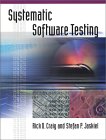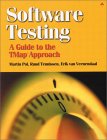My technical skills
My favorites
My picture album
Shortcut keys
My code library
VB resources
SQLServer resources
SQLServer books
Replication FAQ
Scripting resources
ASP resources
Search my site
Sign my guestbook
Contact information
SQL Server Articles New
| Want to keep in touch with the latest in SQL Server world? Email vyaskn@hotmail.com with 'subscribe' in the subject line |
Welcome to the Quality Assurance and Software testing books page. This page lists the leading and best selling software testing books. These top 20 testing books are picked from Amazon.com based on their sales ranks. Click on the image or book title for more information or to purchase this book from Amazon.com
 Test Driven Development: By Example
Test Driven Development: By Example
Presents an approach to writing software that emphasizes automated testing before and during coding. Written for advanced programmers, the book walks through two example projects--multi-currency arithmetic and the xUnit testing framework--and provides patterns for deciding what tests to write and how to write tests using xUnit. The code is written in Java and Python. |
 Lessons Learned in Software Testing
Lessons Learned in Software Testing
Some 300 detailed suggestions are compiled for conducting successful software testing projects, revealing how to manage projects and how to steer clear of common mistakes. Each lesson is an assertion related to software testing, followed by a detailed explanation or example, with topics ranging from test design, automation, and management, to testing strategies and bug reporting. Advice is given on matching the recommended practices to the circumstances of a particular project. Cem teaches computer sciences at the Florida Institute of Technology. |
 Testing Computer Software, 2nd Edition
Testing Computer Software, 2nd Edition
A realistic, pragmatic introduction to testing consumer and business software under normal business conditions. The authors have tested software and managed testers for Silicon Valley software publishers, and wrote the book as a training and survival guide for their staffs. The second edition is more geared to college courses. |
 Managing the Testing Process: Practical Tools and Techniques for Managing Hardware and Software Testing, 2nd Edition
Managing the Testing Process: Practical Tools and Techniques for Managing Hardware and Software Testing, 2nd Edition
Rex Black walks you through how to develop essential tools and apply them to your test project. He helps you master the basic tools, apply the techniques and give each area just the right amount of attention so that you can successfully survive managing a test project! |
 Testing Applications on the Web: Test Planning for Internet-Based Systems
Testing Applications on the Web: Test Planning for Internet-Based Systems
This book describes current technologies, testing concepts, and tools related to e-business applications on the Web. It offers guidance on applying existing skills to the testing of business-to-business, business-to-consumer, and internal Web-based applications. The book specifically describes testing transactions across networks, exploring complex systems of errors, and working efficiently with the numerous components involved. It includes specific instructions for various test types, along with case studies and error examples. |
 How to Break Software: A Practical Guide to Testing
How to Break Software: A Practical Guide to Testing
A practical tutorial on how to actually do testing by presenting numerous 'attacks' you can perform to test your software for bugs. The testing techniques are as flexible as conventional testing is rigid. |
 Testing Extreme Programming
Testing Extreme Programming
This practical tutorial for software builders demonstrates how testing is central to the extreme programming (XP) approach and explains what testing should be done and when and how it should be performed. It overviews the XP methodology, defines the roles of XP team members, shows how to write effective tests before coding begins, and sheds light on refactoring and how it relates to testing. A "road hazard survival kit" offers advice on challenges in testability, project tune-ups, large projects, and extreme testing without extreme programming. |
 Software Testing and Continuous Quality Improvement
Software Testing and Continuous Quality Improvement
Provides the user with a quality standard for the software testing process in structured and unstructured environments. Presents a continuous quality framework based on Deming's rapid application, spiral development model for quality through a continuous improvement process. |
 J2EE Performance Testing with BEA WebLogic Server
J2EE Performance Testing with BEA WebLogic Server
Written by recognised experts in their field who work with J2EE developers on a day-to-day basis, this book provides a detailed reference that can be used to design, evaluate and understand the performance of enterprise J2EE applications. The book has been developed and honed to meet the precise requirements of experienced Java architects, developers or administrators, responsible for building or maintaining such applications. |
 Performance Testing Microsoft .NET Web Applications
Performance Testing Microsoft .NET Web Applications
Describes several tools for testing the performance of web applications under stress, analyzing the results, identifying bottlenecks, and optimizing end user response times. The Microsoft team covers the application center test (ACT), system monitor, network performance analysis, the IIS tier, the SQL tier, and managed code. The CD-ROM contains ACT test scripts and system monitor templates. |
 Automated Software Testing: Introduction, Management, and Performance
Automated Software Testing: Introduction, Management, and Performance
A guide to the various tools, techniques, and methods available for automated testing of software under development. Using case studies of successful industry implementations, the book describes incorporation of automated testing into the development process. In particular, the authors focus on the Automated Test Lifecycle Methodology, a structured process for designing and executing testing that parallels the Rapid Application Development methodology commonly used. |
 Effective Software Testing: 50 Specific Ways to Improve Your Testing
Effective Software Testing: 50 Specific Ways to Improve Your Testing
Exploring 50 important best practices, pitfalls, and solutions, this guide for quality assurance professionals and test managers will help professionals avoid costly mistakes and implement a testing program. Special emphasis is placed on the integration of testing into all phases of the software development cycle, from requirements definition to design and final coding. The 50 lessons focus on key aspects such as test planning, documentation, unit testing, and nonfunctional testing. Dustin is an expert in software engineering and testing who has written other books on software testing. |
 Software Testing
Software Testing
A guide for new and aspiring software testers, covering how software testing fits into the software development process, software testing techniques, and finding a job as a software tester. Shows how to apply testing skills to common testing tasks, how to improve test efficiency with automation, and how to document and measure the test process. Includes quizes and answers. Patton is a software consultant in the private sector. |
 Systematic Software Testing
Systematic Software Testing
Craig (a test manager and consultant) and Jaskiel (an information manager) outline a flexible process for improving software testing capabilities. Focusing on the prevention and early discovery of defects, the testing process described parallels the software development lifecycle. Instructions describe what to test, setting priorities, and completion, with attention to the use of test plans, design, and metrics. Risk analysis and test effectiveness measurement are also discussed. |
 Software Testing in the Real World: Improving the Process
Software Testing in the Real World: Improving the Process
This work offers a toolbox for the practical implementation of the software testing process and how to improve it. Based on real-world issues and examples, it brings together key methods of software testing with practical implementation techniques, and presents a simple, practical approach for those getting started. For those already practising, it provides a guide to the current best practice sources and a framework for the ongoing and sustainable improvement of software testing. |
 Test Process Improvement: A Practical Step-by-Step Guide to Structured Testing
Test Process Improvement: A Practical Step-by-Step Guide to Structured Testing
Experienced software testers from the Netherlands and Belgium explain to development organizations how to take steps to gain control of the testing process and improve it. They introduce their Test Process Improvement model, which works in gradual and controlled steps and realistic goals in terms of quality, lead time, and costs. It can also be used to start a testing program from scratch. |
 Software Testing: A Guide to the Tmap(R) Approach
Software Testing: A Guide to the Tmap(R) Approach
Testing is an essential part of the software development lifecycle, focusing on issues that must be addressed before the information system goes into production. Have all parts and characteristics of the information system been checked sufficiently? Have issues such as suitability, performance and security been looked at? Have all defects been corrected without any new ones being introduced during the re-work process? It is crucial that these questions are not left unanswered until the final stages, so therefore a well-structured and reliable test process is required.TMap (Test Management approach) is a well-established and internationally proven methodology, having been developed in the Netherlands and Belgium by IQUIP Informatica B.V, a software testing specialist. It will help save your company time and money by producing well-designed, reliable quality systems. As the method is non-proprietary and is independent of any development method and platform, you can adapt it to suit your organization and its specific requirements. |
 Software Test Automation: Effective Use of Test Execution Tools
Software Test Automation: Effective Use of Test Execution Tools
Describes how to structure and build an automated testing regime that will give lasting benefits in the use of test execution tools to automate testing on a medium to large scale. Offers practical advice for selecting the right tool and for implementing automated testing practices within an organization, and presents an extensive collection of case studies and guest chapters reflecting both good and bad experiences in test automation. Useful for recent purchasers of test automation tools, technical managers, vendors, and consultants. The authors are consultant partners in a company that provides consultancy and training in software testing and test automation. |
 The Web Testing Handbook
The Web Testing Handbook
The Web Testing Handbook is the definitive resource for testing Web sites and Internet-based applications. Many developers and testers are making the transition from traditional Client/Server, PC, and/or Mainframe systems to testing rapidly changing Web sites and applications. The Web Testing Handbook can help make this transition easier by explaining these new technologies and suggesting test cases and techniques that can be included in a Web site's Functional, Performance, Compatibility, and Usability test plans. Readers will gain an invaluable overview of the most common technologies being used to build Web sites and applications. You will learn proven tips and techniques for testing these Web technologies, obtain a reference of representative Web testing tools, and explore numerous case study checklists that demonstrate effective Web site/application testing. The companion Web site featured in The Web Testing Handbook opens a window into a hands-on, interactive Web testing environment. Readers who put into practice the testing tips and techniques covered in this book will gain real-world Web testing experience. |
 Practical Guide to Testing Object-Oriented Software
Practical Guide to Testing Object-Oriented Software
McGregor (computer science, Clemson University) and Sykes (computer science, Furman University) discuss real-world issues that arise in planning and implementing effective testing for object-oriented and component based software development. The book shows how testing object-oriented software differs from testing procedural software and highlights the challenges and opportunities inherent in object- oriented software testing. It also offers guidance in integrating testing into each stage of development, and describes what to test at each stage. This process, as well as specific testing techniques, are illustrated by a comprehensive example running throughout the book. |


